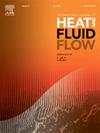Research on flow and heat transfer characteristics of microchannel heat sinks with fan-shaped cavities and circular ribs
IF 2.6
3区 工程技术
Q2 ENGINEERING, MECHANICAL
International Journal of Heat and Fluid Flow
Pub Date : 2025-01-27
DOI:10.1016/j.ijheatfluidflow.2025.109758
引用次数: 0
Abstract
Microchannel heat sinks play a vital role in the heat dissipation of miniaturized and highly integrated electronic devices. In this paper, a novel microchannel heat sinks consisting of fan-shaped cavities and circular ribs (MC-FCR) and the flow and heat transfer characteristics are both studied numerically. With comparation with the traditional smooth straight microchannel (MC), the microchannel with fan-shaped cavities (MC-FC), and the microchannel with circular ribs (MC-CR), the average friction coefficient (f), Nusselt number (Nu) and thermal enhancement efficiency (η) with Reynolds numbers (Re) ranging from 100 to 1000 were mainly studied. The results show that the circular rib structure can increase the degree of turbulence in the microchannel effectively, and the fan-shaped cavity can guide the fluid to form vortices, which bring the average temperature down at least 20 K. In addition, the combination of circular ribs and fan-shaped cavities can improve heat transfer performance while reducing pressure drop, and facilitate the formation of more uniform fluid flow in the channel. Then the relative radius of circular rib (α) and ellipticity (β) are proposed for optimizing the global characteristics of MC-FCR, which results in the thermal enhancement efficiency η for MC-FCR with α = 0.5 and β = 0.5 can achieve 1.431 at Re = 300.
求助全文
约1分钟内获得全文
求助全文
来源期刊

International Journal of Heat and Fluid Flow
工程技术-工程:机械
CiteScore
5.00
自引率
7.70%
发文量
131
审稿时长
33 days
期刊介绍:
The International Journal of Heat and Fluid Flow welcomes high-quality original contributions on experimental, computational, and physical aspects of convective heat transfer and fluid dynamics relevant to engineering or the environment, including multiphase and microscale flows.
Papers reporting the application of these disciplines to design and development, with emphasis on new technological fields, are also welcomed. Some of these new fields include microscale electronic and mechanical systems; medical and biological systems; and thermal and flow control in both the internal and external environment.
 求助内容:
求助内容: 应助结果提醒方式:
应助结果提醒方式:


